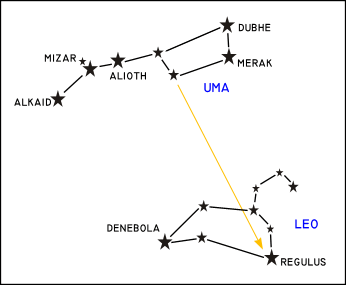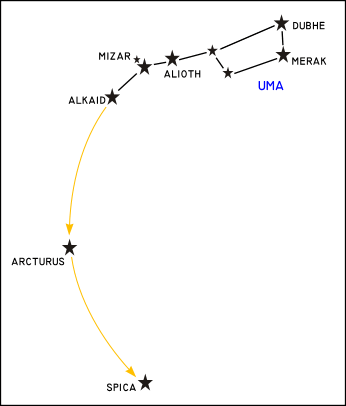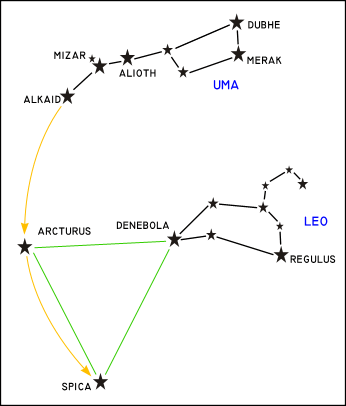|
|
|
|
Salti tra le stelle
|
Star hopping |
|
|
|
|
|
|
|
|
|
 |
Questo è il primo e fondamentale salto; una volta
individuata l'Orsa maggiore - Ursa Major (o meglio il gran carro dell'orsa
maggiore) ci permette di individuare la Stella polare ed anche l'Orsa
minore - Ursa Minor.
This is the first and most important hop.
Once located the Ursa Major (even better, its asterism called the
Plough or
Big
Dipper), we can easily track down the Polaris (Pole Star) and the Ursa Minor (Little
Dipper). |
|
|
|
|
Sempre a partire
dall'Orsa maggiore possiamo individuare la costellazione del
Leone e Regolo che è la sua stella più luminosa. Regolo si
riconosce anche perché rappresenta il puntino di un ipotetico punto
interrogativo rovesciato.
Starting again from the Ursa Major, we can find the
constellation of Leo and its brightest star, Regulus. Regulus is easily
recognizable because is placed as the handle of an imaginary sickle (or
the dot of a reversed question mark). |
 |
|
|
|
|
 |
Facendo ponte sulla polare a partire da Mizar
(la stella centrale del timone del gran carro) si arriva dritti su
Cassiopea (riconoscibile poiché a forma di W)
Starting from Mizar (the central star of the Big
Dipper's handle) and crossing over Polaris we get straightforward on
Cassiopeia (easily distinguishable thanks to the "W" shape). |
|
|
|
|

Questo salto ci fa individuare la
costellazione di Orione caratterizzata anche dalla famosa cintura
(che giace circa sull'equatore celeste). Betelgeuse (rossa) e
Rigel (blu) sono le sue due stelle più luminose. Al suo "interno" ha
anche una grande nebulosa, la M42 chiamata anche Nebulosa di Orione e
visibile facilmente con un binocolo. Partendo dalla cintura si
individuano facilmente Aldebaran della costellazione del Toro
e Sirio della costellazione del Cane maggiore.
This hop makes us find the constellation of Orion and its well known belt,
which lays approximately on the celestial equator. The red Betelgeuse
and the blue Rigel are its brightest stars. Orion also shows the M42
nebula (Great Orion nebula), easily visible by good binoculars.
Prolonging the belt, we can easily find Aldebaran (Constellation of
Taurus) and Sirius (constellation of Canis Major). |
|
|
|
|
Con questo salto si
riesce ad andare dal quadrilatero di Pegaso alla Stella polare
(ma si può fare anche il contrario) utilizzando Caph di Cassiopea
per orientarci.
This hop leads us back to the Polaris starting from the big quadrangle of
Pegasus (even the reverse, if wished) by using Caph (Cassiopeia) as
tracking help. |
 |
|
|
|
|
 |
Seguendo l'arco del Gran Carro si individuano
facilmente Arturo della costellazione di Boote (il
Pastore) e Spiga della costellazione della Vergine.
By ideally prolonging the Big Dipper's arc, we can find
Arcturus (constellation
of Bootes) and Spica (constellation of Virgin). |
|
|
|
|
A completamento del salto precedente possiamo
vedere il triangolo costituito da Arturo, Spiga e
Denebola, la coda del Leone.
To complete the perspective of the previous hop, we can now
observe that Arcturus, Spica and Denebola (Leo's tail) constitute the
vertices of a triangle. |
 |
|
|
|
|

Il Cigno è una costellazione facilmente
visibile in estate; con questo salto ci si arriva con facilità. La
stella più luminosa è Deneb, la coda del Cigno. Insieme ad
Altair della costellazione dell'Aquila e Vega della
costellazione della Lira forma il cosiddetto triangolo estivo.
The constellation of Cygnus can be easily found in summertime and the depicted hop drives
us straight there. Deneb, the Cygnus's tail, is the brightest star and
along with Altair (Aquila) and Vega (Lyra) we can outline the so called
Summer Triangle. |
|
|
|
|
 
Nella figura precedente si trovano tutti i salti finora illustrati e
possono anche essere stampati . .
All the previously depicted hops are
summarized on this  sheet.
sheet. |
|
|
|
|
|







